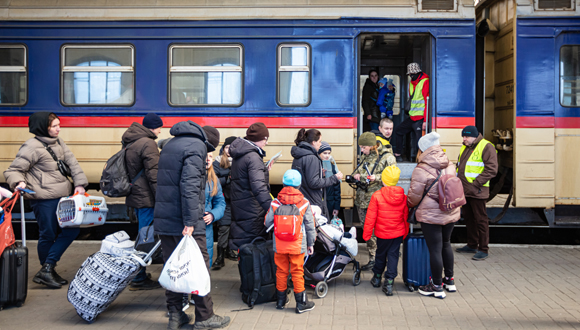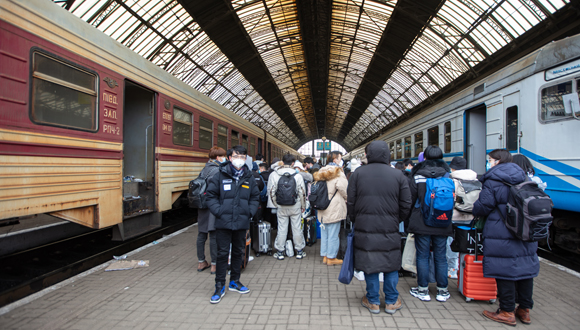
Ukrainian Refugees Arriving in Europe
TAU researcher explains the unprecedented show of EU solidarity.
Over 6.5 million people have fled Ukraine over the last three months, following the Russian military invasion. Several more millions are still making their way to the borders, experts estimate, and numbers may continue to grow, depending on the course and outcomes of the war.
EU’s Efforts
Just one week after the invasion began, the European Union agreed to activate the Temporary Protection Directive adopted by the EU in 2001, after the region first saw a massive influx of refugees following the Yugoslavian war.
The Directive is designed to grant group protection to the migrants, allocating them rights to labor, housing, medical aid and education without processing individual cases at least for one year. It helps alleviate the bureaucratic burden on a host country and enables refugees to achieve a degree of normalcy and stability in their daily lives.
“This is the first time all EU member states have agreed to activate the Directive. It wasn’t activated during the so-called ‘refugee crisis’ in 2015, when over 1,200,000 refugees, mostly from Syria and Afghanistan, were seeking asylum within EU borders, or recently, in 2021, when Afghans were fleeing the Taliban,” notes Professor Anastasia Gorodzeisky, the Head of TAU International M.A. Program in Migration Studies, of the School of Social and Policy Studies at the Gershon H. Gordon Faculty of Social Sciences.
The reason for such an unprecedented show of solidarity? “Ukrainians are perceived by the EU states, especially those of Eastern Europe, as people fighting, at least partially, their own war, which is hitting very close to home,” explains Gorodzeisky. “This wasn’t the case in previous refugee waves.” Activating the Directive helped the Europeans feel they are doing something effective and positive to help the situation, she adds.

Lviv, Ukraine – March 18, 2022: Ukrainian refugees on Lviv railway station waiting for train to escape to Europe
Where Are the Refugees Headed?
Gorodzeisky says that for now, most of the refugees have settled in the countries that share borders with Ukraine – in Poland and Romania – while others made their way to the Czech Republic. “Eventually, some people will make their way to Germany, or even to the UK, which is harder to enter, as it’s no longer a part of the EU,” she continues.
“Refugees are in general naturally attracted to places with large expat communities,” explains Gorodzeisky. “People tend to go to places where they have relatives, friends, or at least some sort of network of support. These people left with nothing, so a network is very important for them.”
At this point, we have no way of predicting when the refugees will be able to return to their home country. “After the 1992 Yugoslavian War, most of the refugees did return. The reason that most Ukrainian refugees stay in the neighboring countries is their desire to return to Ukraine,” predicts Gorodzeisky, adding that personal circumstances will still play a major role in this decision.
Israel’s Role
Gorodzeisky also reflected on Israel’s role in helping Ukrainians. Israel is historically very conservative in taking in refugees, non-conditionally accepting only those with Jewish roots, which it would have done anyway, she says.
“But we’re good at providing humanitarian help in other ways. We have a highly organized civil society, where people take all sorts of high-impact initiatives that make a difference,” she says, citing as an example a website created by Israeli volunteers in the very first days of the war to centralize information about humanitarian aid efforts for Ukraine. Some Israeli volunteers organized evacuation efforts, other provided help online, including instructions on what to do under fire, which drew on the Israelis’ rich experience of living through conflict, Gorodzeisky concludes.
In the period between the beginning of the war, on February 24, up until April 4th, Israel accepted 21,277 Ukrainian citizens, out of which about 7,000 have Jewish roots. Another 7,000 of them have relatives in Israel, and approximately 5,000 have no formal Israeli ties.
“It’s a dynamic situation, and we’re monitoring it,” says Adv. Anat Ben-Dor, who heads TAU’s Refugee Rights Legal Clinic. She adds that Israel now canceled the monetary deposit requirement for the refugees entering the country, which it implemented in the beginning of the war. The Clinic specializes in the legal rights of refugees and asylum seekers, and provides individuals with pro bono legal representation.

Lviv, Ukraine – March 9, 2022: Ukrainian refugees on Lviv railway station waiting for train to escape to Europe
Featured image: Isaccea, Romania. 05 March, 2022. Refugee Ukrainians walk from Ukraine to Isaccea in Romania after crossing the border.
